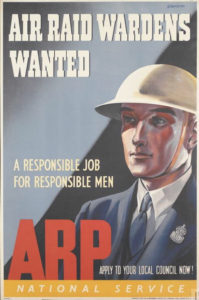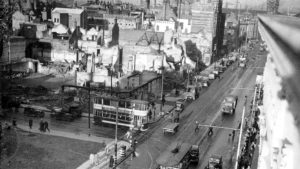Wartime Cinema-Going and the Belfast Blitz: Part 2
Sam Manning continues his exploration of cinema in wartime Belfast, looking at the terrible nights when the bombs finally arrived.
Part 2: The Raids Come
On the night of 7-8 April, the first German raid on Belfast caused relatively minor damage and no cinemas were affected. In the following week, one concerned resident wrote to the Belfast Telegraph observing that cinemas were still full to capacity with many children present, people standing in the aisles and the foyer full of people waiting to gain admittance. ‘I would hate to think what the outcome would be’, they stated, ‘should the place be “blitzed”’.

On the afternoon of 15 April, only a few hours before the Easter raid, Moya Woodside visited a suburban cinema, where she encountered a policeman demanding to see her identity card. He explained that ‘a bomb might fall on the picture-house and it would be difficult sorting out bodies afterwards if they had no identification’. She commented that it was ‘rather a macabre preliminary to our afternoon’s pleasure’.
On that same night, thirteen-year-old Sammy McBride visited the Alhambra on North Street, where he enjoyed a screening of Laurel and Hardy in Saps at Sea. He left the cinema at around 10.30pm and then visited a friend on the Shankill Road. He later recalled that on his way home back to the Ardoyne an incendiary bomb fell in front of the Holy Cross Chapel.
That was the beginning of the most destructive raid which took the lives of over 900 Belfast citizens. It is fortunate, however, that cinemas were empty during these night attacks as many were hit by the falling bombs. The Shankill Picturedrome suffered relatively minor damage and was able to open only three weeks later. The Popular (known locally as the Pop), located in the Short Strand area of east Belfast, suffered more serious damage, becoming a roofless shell for the remainder of the conflict.
The worst hit cinemas were those nearby to the docks and factories in the York Street area of north Belfast. Both the Queen’s and the Midland (known locally as Joe’s after the owner Joe McKibben) received direct hits and were destroyed completely. Despite the fact that the Midland was one of Belfast’s more downmarket cinemas, it was a popular local venue and annual admissions had increased from 375,000 in 1939 to 433,000 in 1940.

The raid on the night of 4–5 May claimed the lives of a further 150 people. Much of the damage occurred on the harbour, Queen’s Island and residential areas in east Belfast, but bombs also landed on the city centre, including the Lyric cinema on High Street. Only the bare walls of the cinema remained and Michael Open later wrote that ‘in the days after the raid, passers by could still see the beautiful old projection equipment which had shown them so many happy wonderful films’.
In the following week, traction engines arrived to help pull down the remaining façade. The Irish Independent wrote that the destruction of a billboard advertising Arthur Lucan in Mother Riley in Business offered ‘a pathetic reminder of the cinema’s last show’. The tragedy was later exacerbated by death of the cinema’s owner in September 1942.
